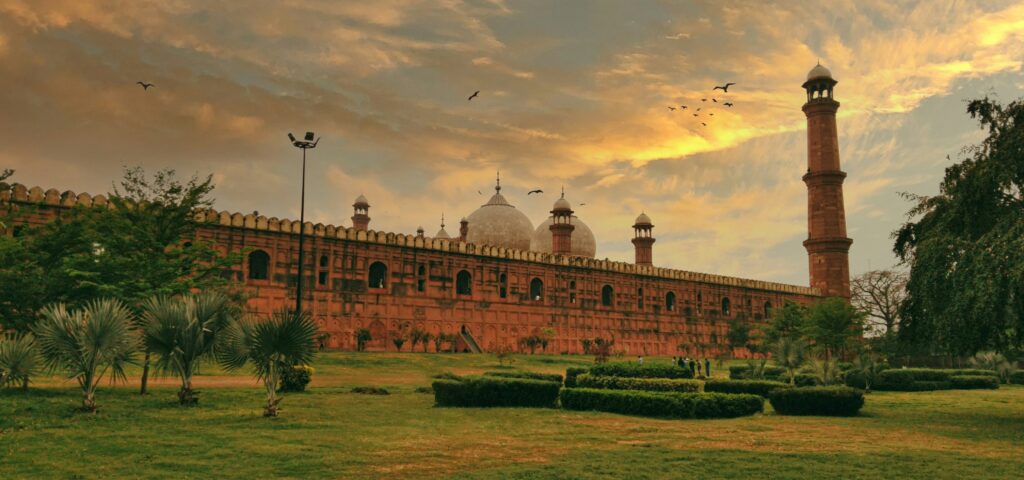Ever wondered where ancient empires left their marks? Pakistan holds the secrets of lost civilizations, majestic empires, and timeless architecture. In this blog post, we explore the Top 15 Historical Sites in Pakistan for Culture Lovers, revealing remarkable destinations that showcase the country’s vibrant culture, deep-rooted history, and rich heritage. Whether you’re a history buff, an adventurer, or simply curious about Pakistan’s past, these sites are sure to captivate your imagination.
Also read:
- Why visit historical places in Pakistan?
- Travel Tips for Visiting Historical Sites in Pakistan.
- Top 10 Best Places to Visit in Pakistan for Tourists.
- Best time to visit Northern Pakistan.
The Ultimate List of Historical Places in Pakistan:
1. Lahore Fort and Shalimar Gardens
“Highlights of Mughal Grandeur”
Let’s begin our journey in Lahore. These two historical sites show the rich culture of the Mughal Empire. People know the Lahore Fort for its Sheesh Mahal (Palace of Mirrors), Naulakha Pavilion, and Alamgiri Gate. The nearby Shalimar Gardens shine with flowing water, marble fountains, and peaceful paths. These gardens were once used for royal ceremonies. Together, they offer a magical experience for culture lovers.
2. Badshahi Mosque
“A Symbol of Islamic Majesty”
Next, we visit one of the world’s largest mosques. Built in 1673, the Badshahi Mosque has red sandstone walls and a white marble interior. Its size and beauty make it one of the top historical sites in the country. Culture lovers are drawn to its peaceful atmosphere and grand design.
3. Mohenjo-Daro
“Legacy of the Indus Valley Civilization”
Now, let’s go even further back in time. Mohenjo-Daro, in Sindh, is over 4,000 years old. It was one of the main cities of the Indus Valley Civilization. The city had planned streets, drainage systems, and brick homes. Important finds include the Great Bath and the Priest-King statue. It’s a remarkable experience for history and culture lovers.
4. Rohtas Fort
“Strategic Defense Architecture”
Our next stop is Rohtas Fort, built in the 1500s. They designed it to stop invaders and protect the land. Its thick walls and tall watchtowers show strong military skills. The fort mixes Afghan and Turkish styles. That’s why it’s counted among the top historical sites in Pakistan.
5. Taxila Ruins
“Centre of Buddhist Learning”
Moving to the north, Taxila was once a great learning place for Buddhists. This historical site has ancient monasteries, stupas, and schools. The Dharmarajika Stupa and Jaulian Monastery are key spots to visit. Culture lovers can explore how people lived and learned in those times.
6. Makli Necropolis (Thatta)
“A City of Silence and Stone”
Makli is one of the largest graveyards in the world. It covers more than 10 square kilometers. Here, thousands of rulers, saints, and scholars are buried. Their tombs are beautifully carved and show a mix of Islamic, Persian, and Hindu styles. This quiet place is a must-see for anyone interested in unique historical sites.
7. Ranikot Fort
“The Great Wall of Pakistan”
Experts believe that this huge fort, around 32 km long, is the largest in the world by circumference. It is also called the “Great Wall of Pakistan” because of its long outer walls. Researchers trace its roots to the Sassanian era, but scholars argue about this. The fort has many gates and watchtowers. It also offers great hilltop views. This makes it a popular spot for history lovers and explorers.
8. Derawar Fort
“Desert Fortress of Cholistan”
Deep in the Cholistan Desert stands Derawar Fort. Its 40 huge towers rise from the sand, making it hard to miss. First built by Rajput rulers, it was later used by the Nawabs of Bahawalpur. It’s a perfect spot for travelers who enjoy historical sites with desert views and royal stories.
9. Noor Mahal (Bahawalpur)
“Royal Elegance in the Desert”
Noor Mahal is a palace that looks like it came from a fairytale. Built in 1875, it combines Islamic and European styles. Inside, it’s filled with grand furniture and art. This site reflects the royal life of Bahawalpur and is loved by culture lovers.
10. Minar-e-Pakistan
“Birthplace of a Nation”
On 23 March 1940, delegates approved the Pakistan Resolution at Minar-e-Pakistan. Minar-e-Pakistan is a national symbol. It marks the place where the Pakistan Resolution was passed in 1940. The tall tower blends Mughal, Islamic, and modern designs. Located in a public park, it is an important historical site for those who want to learn about Pakistan’s creation.
11. Harappa
“Sister City of Mohenjo-Daro”
Harappa, located in Punjab, was also part of the Indus Valley Civilization. Like Mohenjo-Daro, it had planned streets and skilled artisans. Items like pottery, tools, and skeletons have been found here. For culture lovers, this is a place full of stories from thousands of years ago.
12. Faisal Mosque (Islamabad)
“A Modern Icon”
In the capital city, Islamabad, stands the beautiful Faisal Mosque. It has a modern look but stays true to Islamic design. The mosque can hold over 100,000 people. With the Margalla Hills in the background, it is one of the most photographed historical sites in Pakistan.
13. Baltit Fort (Hunza)
“A Fortress in the Clouds”
High in the mountains of Hunza sits Baltit Fort. It’s more than 700 years old and was once home to the local rulers. With its wooden balconies and stone walls, it gives a true feel of mountain life. It’s a favorite for culture lovers exploring the north.
14. Wazir Khan Mosque (Lahore)
“A Hidden Jewel of the Mughal Era”
In the 17th century, artisans built the Wazir Khan Mosque. Hidden in Lahore’s old city, Wazir Khan Mosque is full of color and charm. Built in the 1600s, it features amazing tile work and calligraphy. It’s smaller than other mosques but just as beautiful. This gem is a must-visit for those who love historical sites with artistic detail.
15. Chaukhandi Tombs (Karachi)
“A Forgotten Cemetery with Unique Craftsmanship”
Our last stop is near Karachi. The Chaukhandi Tombs are old graves from the 15th to 18th centuries. Made of sandstone, they are carved with flowers, patterns, and symbols. These tombs are special for culture lovers who enjoy hidden and peaceful historical sites.
Travel Tips for Visiting Historical Sites in Pakistan
Exploring Pakistan’s historical wonders can be an unforgettable experience—if done correctly. To help you make the most of your trip, here are some valuable travel tips:
Plan for your historical journey.
- Do your research on each site to understand its history and significance.
- Build a flexible itinerary that groups nearby sites to save time.
- Check the entry fees, opening hours, and whether they allow photography.
Hire Local Guides
- Local guides make your visit better. They share stories, historical insights, and cultural views that you might miss alone.
- Many guides are multilingual and can help bridge communication gaps with locals.
- A good guide also ensures you do not overlook hidden details or restricted areas.
Respect Cultural Norms
- We recommend modest clothing, especially at religious or conservative sites.
- Always ask for permission before taking photos of people or sacred places.
- Avoid littering and follow the signs or instructions posted on site.
Pack light and smart.
- Wear breathable, modest clothing suitable for walking and the climate.
- Comfortable walking shoes are a must for sites with uneven terrain.
- Essentials include sunscreen, hats, water bottles, snacks, and a portable charger.
Best Time to Visit
- The ideal travel window is from October to March when the weather is mild.
- Stay away from peak summer (May–August). Temperatures can be very high, especially in southern and desert regions.
- Early mornings and weekdays are the best times to visit popular sites to avoid crowds.
Stay safe and informed.
- Always travel with a local contact or guide if you’re unfamiliar with the area.
- Stay updated on weather and road conditions, especially in remote regions.
- Carry a copy of your ID and important contacts, and make sure your phone is fully charged.
Why visit historical places in Pakistan?
Visiting historical sites is more than just looking at old buildings. It’s like stepping into a time machine. You get to walk through the past and explore stories carved in stone, painted on walls, or hidden in ancient ruins.
Pakistan has a long and rich history. For thousands of years, different civilizations lived here. Each one left behind its own culture, art, and architecture. From the grand Mughal buildings in Lahore to the peaceful Buddhist monasteries of Taxila, and from the ancient cities like Mohenjo-Daro and Harappa to beautiful Islamic sites like Faisal Mosque and Wazir Khan Mosque—every place tells a unique story.
These places aren’t just interesting—they are important. Many of them are listed as UNESCO World Heritage Sites, which means they are special to the whole world. That’s why Pakistan is a top destination for culture lovers and anyone who enjoys learning about the past.
Exploring the top historical sites in Pakistan helps us understand how people lived, what they believed in, and how they shaped the land we live in today. These landmarks are full of stories about kings and queens, warriors and saints, artists and builders. They speak of beauty, power, faith, and strength.
So, if you love culture and history, Pakistan is a treasure chest waiting to be discovered.
Final Thoughts: Uncover the Soul of Pakistan
Historical places in Pakistan are more than just stone structures—they are storytellers. Every fort, mosque, and ruin hide secrets of empires, cultures, and beliefs that shaped the subcontinent. No matter if you’re a seasoned traveler or new to it, these sites offer amazing experiences.
So, are you ready to travel to historical places in Pakistan and uncover the magic of the past? Your journey through time begins now.
FAQs about historical places in Pakistan
What are the most famous historical places in Pakistan?
Lahore Fort, Badshahi Mosque, Mohenjo-Daro, and Rohtas Fort are among the most famous sites.
Which is the oldest historical site in Pakistan?
Mohenjo-Daro and Harappa are the oldest, dating back over 4,000 years.
How many UNESCO World Heritage Sites are there in Pakistan?
As of now, Pakistan has six UNESCO World Heritage Sites.
Are historical places in Pakistan safe for tourists?
Yes, most major historical sites are safe and attract many tourists. Always check local travel advisories and plan with a trusted guide.



This piece is a perfect blend of intellect and heart. The ideas you present are complex, but you navigate them with such ease that it feels like you’re inviting the reader to walk alongside you, step by step, through a maze of thought and emotion. It’s the kind of writing that challenges you and comforts you all at once.
Thank you so much.